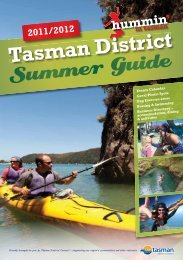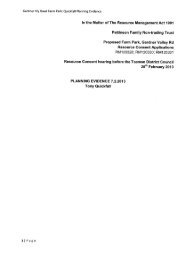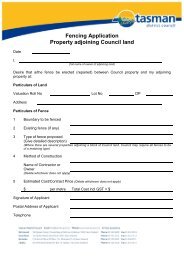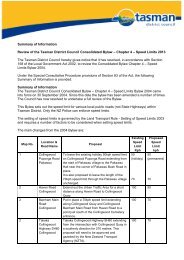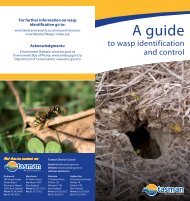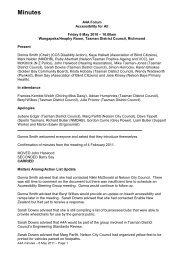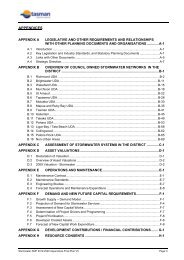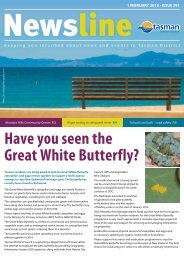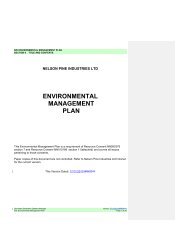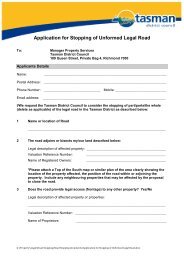Application For Resource Consent To Discharge Domestic ...
Application For Resource Consent To Discharge Domestic ...
Application For Resource Consent To Discharge Domestic ...
Create successful ePaper yourself
Turn your PDF publications into a flip-book with our unique Google optimized e-Paper software.
<strong>Application</strong> <strong>For</strong> <strong>Resource</strong> <strong>Consent</strong><br />
<strong>To</strong> <strong>Discharge</strong> <strong>Domestic</strong> Wastewater<br />
Includes changes to conditions and renewals<br />
<strong>To</strong>: Co-ordinator Customer Services<br />
Tasman District Council<br />
Private Bag 4<br />
Richmond<br />
Nelson 7050<br />
FOR OFFICE USE ONLY<br />
<strong>Consent</strong> No:<br />
Customer No:<br />
Fee:<br />
Receipt No:<br />
PART A: Contact Details<br />
1. Applicant(s) Details<br />
Pursuant to Section 88 of the <strong>Resource</strong>s Management Act 1991, the undersigned hereby applies for a permit in accordance to the details below.<br />
Company Name: (if applicable)<br />
First Name(s)<br />
First Name(s)<br />
First Name(s)<br />
Surname:<br />
Surname:<br />
Surname:<br />
Nature of Applicant (i.e. owner, lessee, prospective purchaser, developer)<br />
Contact Person Details (if applicable)<br />
Name of Contact Person:<br />
Postal Address:<br />
PO Box Number: City: Postal Code:<br />
Street Address (If different from above)<br />
Phone Numbers:<br />
Business:<br />
Mobile:<br />
Private:<br />
Fax:<br />
Email Address:<br />
2. Consultant/Agent Details (if applicable)<br />
Consultant/Agent Name:<br />
Postal Address:<br />
PO Box Number: City: Postal Code:<br />
Street Address (If different from above)<br />
EP-RC022 07/10<br />
1/12
Phone Numbers:<br />
Business<br />
Mobile<br />
Private<br />
Fax<br />
Contact Person<br />
3. All correspondence relating to this application should be sent to:<br />
Applicant Consultant/Agent Other (specify)<br />
4. Are there any existing discharge consents relating to this proposal or other discharge/disposal<br />
on the site? Yes No<br />
If YES, give Reference Number(s) and Description<br />
5. List any other consents required in relation to this proposal and indicate whether<br />
or not they have been applied for: (e.g. water permit, land use consent, subdivision consent)<br />
PART B: Property Details<br />
1. Please describe the dwelling/property of which this wastewater system will serve, you must specify<br />
the maximum number of occupants that can be accommodated<br />
(ie. Number of bedrooms, camp sites etc) water usage fixtures (ie. Dishwasher, in-sink garbage disposal unit, washing machine, spa bath etc.)<br />
2. Property for which this application relates:<br />
Physical Address of Property<br />
<strong>To</strong>tal Property Area (ha)<br />
Property valuation Number<br />
3. Legal description of land: (as shown on Certificate of Title)<br />
Lot DP CT<br />
Please attach a copy of the Certificate of Title. If you do not supply this, the cost of obtaining a copy will be included in the permit processing costs.<br />
4. What is the map reference of the proposed disposal system? (if known)<br />
NZMS260 Series number<br />
Easting (7 digit number) Northing (7 digit number)<br />
PART C: Point of <strong>Discharge</strong><br />
1. Location<br />
Is the wastewater disposed of on the site of origin? Yes No<br />
If yes, please move onto Section D. If no, please complete the rest of this section.<br />
2/12
2. Property details of point of discharge: (if different from property of origin)<br />
a) Name of owner<br />
Address/Location<br />
b) Legal Description of land where discharge point is situated (as shown on Certificate of Title)<br />
Lot DP CT<br />
c) Attach the property owners if different owner to applicant.<br />
3. Describe the location of the point of discharge or disposal area, in relation to the property. Provide plan<br />
showing location of discharge site.<br />
4. What is the map reference of the proposed disposal system? (if known)<br />
NZMS260 Series number<br />
Easting (7 digit number) Northing (7 digit number)<br />
PART D: General Site Assessment<br />
1. Provide a general description of the locality (in particular location of waterways and the coastal marine area).<br />
2. <strong>To</strong>pography<br />
a) Is the proposed disposal area situated on a slope? Yes No<br />
b) If YES, state the approximate slope angle (e.g. 10 Deg) Deg<br />
3. Site Stability<br />
a) Has expert evaluation of the site stability been undertaken Yes No<br />
If NO, why not?<br />
b) Report attached Yes No<br />
If YES, please attach a copy of the stability report<br />
PART E: Subsoil Investigation<br />
1. Please identify the soil profile determination method<br />
Test Pit (Depth m) No. of Test Pits<br />
Bore Hole (Depth m) No. of Bore Holes<br />
Other (specify) Soil report attached Yes No<br />
Please provide a written description of the soil profile at the disposal area.<br />
3/12
2. Has the permeability of the soil been assessed? (An assessment is mandatory if proposed application rates differ from those<br />
recommended in AS/NZS 1547:2000). The recommended method is outlined in AS/NZS 1547:2000 Appendix 4.1F<br />
Yes<br />
No<br />
If another method was used please specify. Attach a copy of the results.<br />
3. Water table details. From ground level, what is the depth of the water table in:<br />
Winter m Please indicate whether measured or estimated (please tick)<br />
Summer m Please indicate whether measured or estimated (please tick)<br />
(Note: the water table level in nearby bores could be used.)<br />
4. What depth of topsoil was found at the disposal site?<br />
depth<br />
(m)<br />
5. Based on the results of subsoil investigation in Part E 1 and Part E 2 above please indicate<br />
the soil category of the subsoil of the disposal field (complete both soil texture and structure).<br />
Soil Category Soil Texture Indicative Drainage Class Structure<br />
1 Gravels and sands (see note 1) Rapidly drained Structureless (Massive)<br />
2 Sandy loams Well drained Weakly structured<br />
Massive<br />
3 Loams Moderately well drained High /moderate structured<br />
Weakly structured or massive<br />
4 Clay loams Imperfectly drained High /moderate structured<br />
Weakly structured<br />
Massive<br />
5 Light clays (see note 2) Poorly drained Strongly structured<br />
Moderately structured<br />
Weakly structured or massive<br />
6 Medium to Heavy (see note 2) Very poorly drained Strongly structured<br />
Table adapted from AS/NZS 1547:2000 Table 4.1.1<br />
Note 1<br />
Category 1 soils require special design and distribution techniques to help achieve even distribution of wastewater over the full design<br />
surface. These soils have low nutrient retention capacities, often allowing accession of nutrients to groundwater, so secondary treatment<br />
of wastewater is generally required.<br />
Note 2<br />
<strong>To</strong> enable utilisation of Category 5 and 6 soils for onsite wastewater disposal, alternative systems, special design requirements and<br />
distribution techniques and/or soil modification procedures will be necessary to ensure performance standards are met. Secondary<br />
treatment of wastewater is generally required.<br />
PART F: <strong>Discharge</strong> Details<br />
1. Please indicate the water supply source for the property identified in Section A<br />
Bore/well Rainwater (roof collection) Public supply<br />
What is your daily entitlement from this source?<br />
litres per day (if relevant)<br />
4/12
2. Using the following table please calculate the estimated maximum daily volume of wastewater to be<br />
discharged unless accurate water meter readings are available. If differing volumes are proposed please<br />
provide a justification for this in an attached report.<br />
Typical wastewater flow allowance (litres/ day)<br />
Source Maximum Occupancy Onsite Tank Supply <strong>To</strong>wn/Bore Supply <strong>To</strong>tal Volume (litres/day)<br />
Households with standard facilities 140 180<br />
Households with extra wastewater<br />
170 220<br />
producing facilities (garbage grinders,<br />
dishwashers)<br />
Motels/Hotels<br />
guests, resident staff 140 180<br />
non-resident staff 30 40<br />
reception rooms 20 30<br />
bar trade 20 25<br />
Community Halls<br />
banqueting 20 30<br />
meetings 10 15<br />
Restaurants (per diner)<br />
dinner 20 30<br />
lunch 15 25<br />
Tea Rooms (per customer)<br />
without restroom facilities 10 15<br />
with restroom facilities 15 25<br />
Schools (pupils plus staff) 30 40<br />
Rural Factories, Shopping Centres 30 50<br />
Camping Grounds<br />
fully serviced 100 130<br />
recreation areas 50 65<br />
Please specify any expected seasonal fluctuations.<br />
Note: These estimates are a guide only adapted from AS/NZS 1547:2000 and actual values will vary depending on water fixtures<br />
and individual water use.<br />
3. Do you propose to install:<br />
a) Water conservation devices Yes No<br />
b) Water recycling Yes No<br />
If you answered YES, please provide additional information including the estimated reduction in water usage.<br />
PART G: Primary Treatment<br />
1. Please indicate below the number and capacity (litres) of all septic tanks including type<br />
(single/dual/grease traps) to be installed or currently existing<br />
No. of Tanks Type of Tank Capacity (litres)<br />
<strong>To</strong>tal Capacity<br />
5/12
2. Are biosolid filters proposed to be installed to the septic tank outlets?<br />
Yes No<br />
If YES, please state the type<br />
Note: The use of filters is strongly recommended to improve solids retention and avoid damage to the disposal field.<br />
PART H: Secondary and Tertiary Treatment<br />
1. Please indicate below the type of additional treatment, if any, proposed to be installed in the system.<br />
Home aeration plant<br />
Commercial aeration plant<br />
Intermittent sand filter<br />
Recirculating sand filter<br />
Clarification tank<br />
Ultraviolet disinfection<br />
Chlorination<br />
Other (specify)<br />
PART I: Expected quality of wastewater<br />
1. What is the expected quality of wastewater being discharged into the disposal field?<br />
Biochemical oxygen demand<br />
milligrams/litre<br />
Suspended solid<br />
Faecal coliforms<br />
milligrams/litre<br />
cfu/100ml<br />
Other effluent quality information/comments:<br />
PART J: Disposal Method<br />
1. Please identify the type(s) of disposal method proposed for this site<br />
Surface dripper irrigation Go to Q 1.2 below<br />
Sub-surface dripper irrigation<br />
Trench<br />
Deep trench<br />
Spray irrigation<br />
Mound<br />
Evapo-transpiration beds<br />
Go to Q 1.2 below<br />
Go to Q 1.1 below<br />
Go to Q 1.1 below<br />
Go to Q 1.2 below<br />
Go to Q 1.1 below<br />
Go to Q 1.1 below<br />
Other (specify)<br />
6/12
1.1 Disposal Method – Soakage Trench/Bed System<br />
What are the dimensions of the proposed soakage trench/beds?<br />
Width mm Depth mm<br />
What is the total length of all the soakage trenches/beds?<br />
m<br />
Distance to groundwater (winter level m)<br />
How will the soakage trench/bed system be loaded?<br />
Trickle Pump Dose loaded via syphon<br />
Has a 100% reserve area of undeveloped land been allowed for in the disposal system design?<br />
(Reserve areas should be clearly marked on the design map submitted with the application).<br />
Yes<br />
No<br />
If NO, what percentage has been allowed for and why?<br />
1.2 Disposal Method – Irrigation<br />
What area will the irrigation lines cover?<br />
What is the distance between adjacent irrigation lines?<br />
Has a 100% reserve area of undeveloped land been allowed for in the disposal system design?<br />
(Reserve areas must be clearly marked on the design map submitted with the application).<br />
Yes<br />
No<br />
If NO, what percentage has been allowed for and why?<br />
2. Please identify the loading rate you propose for the option selected in question 1 above and state the<br />
reasons for selecting this loading rate.<br />
Loading rate<br />
Explanation<br />
l/m2/day<br />
3. Please provide a plan of the site which details description the design and dimensions of the disposal field<br />
including a detailed plan of the field relative to the property boundaries, nearby groundwater bores and<br />
surface water bodies.<br />
7/12
PART K: Operation and Maintenance<br />
1. Have Operation and Maintenance Guidelines been provided for the system?<br />
Yes No If YES, please attach copy.<br />
2. How is the system to be serviced/maintained/cleaned?<br />
As per maintenance contract of supplier (attach copy of signed contract)<br />
Individual responsibility<br />
If so, please provide details of maintenance requirements including pumpout frequency.<br />
3. What contingency measures have been proposed to alert the owner/occupier or maintenance provider<br />
of malfunctions in the system?<br />
4. Has an access point to allow sampling been provided?<br />
Yes No Note: all systems installed after 19 September 1998 must include a sampling point.<br />
PART L: Assessment of Environmental Effects<br />
1. Is an Assessment of Environmental Effects (AEE) included with the application?<br />
Yes<br />
No<br />
2. Please ensure the following items have been addressed in the AEE (please tick)<br />
a) A description of the sensitivity of the receiving environment, in particular the potential for the proposed system to have any impact<br />
on ground and surface water and/or coastal water quality. Your AEE must identify the location of any downstream bores and any<br />
potential adverse effects.<br />
b) Details (where appropriate) of any seasonal fluctuations in flows and how this may affect the seasonal or long term performance<br />
or capacity of the system<br />
c) Details of any proposed mitigation/contingency measures to be undertaken to help prevent or reduce the actual or potential effect.<br />
d) Any possible alternative methods of discharge, including discharge into any other receiving environment.<br />
e) Where the scale or significance of the activities effect are such that monitoring is required a description of how, once the proposal<br />
is approved effects will be monitored and by whom.<br />
PART M: Affected Parties<br />
Consultation with all interested and affected parties is recommended. Potentially affected parties can include neighbours, Department of<br />
Conservation, Fish and Game Council, local iwi, recreational organisations etc. If you are proposing to dispose of your wastewater using a deep<br />
soakage system, the determination of affected parties can be more complex, especially in relation to groundwater users. It is recommended that<br />
you contact Tasman District Council to help determine who the affected parties from your proposal may be. Written approval is required from all<br />
parties Council deem to be affected by your proposal.<br />
Attach copies or written approval forms completed by all affected parties where required.<br />
Where written approval has not been obtained but is required, please explain the reasons for not obtaining approval.<br />
A failure to gain affected party approval may require Council to publicly notify your application.<br />
8/12
PART N: Is Your <strong>Application</strong> Complete?<br />
1. In order to provide a complete application, have you remembered to?:<br />
• Fully complete this application form and attached any additional information requested (ie. Site stability assessment report).<br />
• Include a location plan (with scale bar) and site plan<br />
This plan must illustrate –<br />
– The legal property boundaries of your lot and the distance to your disposal system (including reserve areas) from those<br />
– The layout of your treatment and disposal systems (including reserve areas) within your lot boundaries<br />
– Location of any nearby groundwater bores to your disposal system (including reserve areas)<br />
– Location of any surface water within 20 metres of your disposal system<br />
• Enclose a Certificate of Title<br />
• Attach an Assessment of Environmental Effects including signed affected party forms if required<br />
• Attach the deposit fee. Cheques payable to Tasman District Council<br />
2. Declaration<br />
I hereby certify that, to the best of my knowledge and belief, the information given in this application is true and correct. I undertake<br />
to attach the required aerial photo of the property. I also undertake to pay all actual and reasonable application processing costs<br />
incurred by the Tasman District Council.<br />
Name:<br />
Position:<br />
Signature of applicant:<br />
Date:<br />
9/12
Background: Tasman <strong>Resource</strong><br />
Management Plan (TRMP)<br />
Chapter 36 of the Tasman <strong>Resource</strong> Management Plan addresses<br />
discharges of contaminants to the environment, land, air and water.<br />
The discharge to land of up to 2000 litres per day of domestic<br />
wastewater is a permitted activity in many areas (excluding Rural<br />
3 Rural 3A zones and the Services Contribution Areas) provided<br />
compliance with a number of conditions of the relevant rule.<br />
Properties located within a Special <strong>Domestic</strong> Wastewater Disposal<br />
Area must comply with more stringent wastewater quality standards<br />
than those in other permitted areas, secondary treatment of<br />
wastewater is mandatory in these areas. Any discharge of domestic<br />
wastewater in the Rural 3, Rural 3A and Services Contribution Areas or<br />
that is unable to meet the requirements of the permitted activity rules<br />
is a discretionary activity in accordance with Rule 36.1.16, resource<br />
consent is required. Please speak with Council staff to ascertain the<br />
regulations that apply at your locality.<br />
Reference copies of the TRMP are available at Council’s offices and<br />
libraries and copies of the relevant policies and rules can be obtained<br />
from Council’s offices.<br />
Part A: Contact Details<br />
1. Applicant(s) Details<br />
A resource consent can only be held by a legal organisation<br />
or fully named individual(s). A legal organisation includes a<br />
limited company, incorporated group or registered trust. If the<br />
application is not for one of the above, then you may use fully<br />
named individual(s) and the organisation name.<br />
2. Consultant/Agent Details<br />
If you are using a consultant/agent for this application put their<br />
details here. If you are not you should leave question 2 blank.<br />
3. Correspondence<br />
Do you want correspondence (letters/phone calls) to be sent to<br />
you or your consultant if you have one?<br />
4. <strong>Discharge</strong> <strong>Consent</strong><br />
Do you have an existing resource consent (from TDC) to discharge<br />
domestic wastewater? If so, please enter the permit number if<br />
known and a brief description including the date of issue.<br />
5. Additional <strong>Consent</strong>s<br />
Do you require any additional consents ie. landuse, subdivision,<br />
earthworks from TDC?<br />
Part B: Property Details<br />
Please attach a copy of the current Certificate of Title.<br />
Part C: Point of <strong>Discharge</strong><br />
1. Location<br />
An onsite disposal system is one that provides for the treatment<br />
of waste within the property boundaries of the place of origin.<br />
2. Property Owner<br />
Please state the name and address of the property owner where<br />
the wastewater will be discharging if it is different to the address<br />
of the property from which it is produced.<br />
3. Physical Location<br />
Please identify the physical location of the disposal area. A plan<br />
of the site should clearly show the discharge point relative to<br />
buildings, other property boundaries and any nearby waterways<br />
and water supply bores.<br />
Part D: General Site Assessment<br />
1. Provide a general description of the locality, including proximity<br />
to waterways and the coastal marine area.<br />
2. An assessment of the site geology may be required to assess<br />
the stability of the land forms. It is important to be sure that the<br />
onsite disposal of wastewater will not compromise the stability<br />
of that site and result in damage to the treatment system,<br />
buildings or the environment. Onsite disposal of wastewater has<br />
the potential to encourage slumping or slippage of the soil by<br />
increasing soil wetness in the vicinity of the disposal area.<br />
Part E: Subsoil Investigation<br />
1. Soil Profile<br />
A soil profile determination to the limiting horizon (hardpan,<br />
bedrock, seasonal water table) which identifies and documents<br />
soil type, texture and structure is required (as detailed in AS/<br />
NZS1547:2000).<br />
2. Permeability Assessment<br />
Various methods are available to test soil permeability, an<br />
assessment is mandatory if proposed application rates differ<br />
from those recommended in AS/NZS1547:2000 for the soil<br />
category identified at the site. Recommended method is<br />
provided in AS/NZS 1547:2000.<br />
3. Depth of Seasonal Water Table<br />
Where subsoil investigations are carried out in summer some<br />
estimate of winter high water table is necessary. This is important<br />
for assessing the amount of pre-treatment in the soil the effluent<br />
will receive before reaching groundwater.<br />
4. Subsoil Investigation<br />
Soil categories should be classified in accordance with AS/<br />
NZS1547:2000).<br />
Part F: <strong>Discharge</strong> Details<br />
1. Water Supply Source<br />
Has a significant influence on estimated wastewater production.<br />
2. Wastewater Flow<br />
Design flows should be based in the maximum number of persons<br />
occupying the premises and take into account the nature of the<br />
occupancy, refer to AS/NZS1547:2000 Appendix 4.2D.<br />
3. Water Conservation Devices<br />
Some consideration will be given for proposals which intend<br />
to install water conservation devices as these can significantly<br />
reduce estimated wastewater flows, however, potential<br />
ownership changes will be taken into account.<br />
Part G: Primary Treatment<br />
1. Capacity of Septic Tanks<br />
Septic tank capacities should provide room to store both the<br />
consolidating sludge and floating scum, and allow a minimum of<br />
24 hours settling volume for daily flow within the central liquid<br />
zone at sludge/scum fall condition and based upon design flows.<br />
They should be designed to provide a maximum interval prior to<br />
desludging/pumpout of 5 years, although 3 yearly desludging<br />
is recommended in practice. AS/NZS1547:2000 provides some<br />
guidance for tank capacity requirements.<br />
2. Improved primary treatment<br />
Septic tanks provide separation of suspended material from<br />
wastewater by settlement and/or flotation in septic tanks,<br />
modifications of the basic septic tank model (ie. multistage tank,<br />
outlet filters) are required to minimise the likelihood of solid material<br />
being carried over into the disposal field causing clogging and failure.<br />
10/12
Part H: Secondary and Tertiary Treatment<br />
1. Additional Treatment<br />
Additional treatment of the primary treated effluent is<br />
recommended to improve the quality of effluent discharged into<br />
the receiving environment and therefore reduce the potential for<br />
adverse environmental effects arising from the discharge.<br />
Part I: Effluent Quality<br />
Expected effluent quality will depend on the level of treatment<br />
prior to discharge to the disposal field, primary treated effluent<br />
from a well operated septic tank is expected to produce<br />
results of approximately BOD2 120-150 milligrams per litre,<br />
total suspended solids 50-70 milligrams per lite and 103 faecal<br />
coliforms per 100 millilitres, these may be improved slightly<br />
with the addition of simple devices (ie. filters, multi chamber).<br />
Some form of secondary treatment (ie. aerated wastewater<br />
treatment system recirculating sand filter) is required to produce<br />
a significant lowering of contamination concentrations in the<br />
effluent, AS/NZS1547:2000 considers secondary wastewater<br />
to be treated to a level of BOD5 approximately 20 milligrams<br />
per litre and total suspended solids 30 milligrams per litre.<br />
However, in order to significantly address pathogen level of the<br />
wastewater, tertiary treatment is generally required.<br />
Part J: Disposal Method<br />
The disposal method must be selected and designed in<br />
accordance with AS/NZS1547:2000. A number of factors must<br />
be taken into account when selecting an appropriate system,<br />
including:<br />
• the volume of wastewater produced<br />
• characteristics of the wastewater<br />
• the quality of wastewater discharging from the wastewater<br />
treatment system<br />
• the nature of the soil profile and resulting soil category<br />
• topography and geology of the site<br />
• the design loading rate associated with that soil category<br />
• the required spacing between trenches/beds/irrigation lines<br />
or sprays<br />
• surface water and groundwater levels and movements<br />
• local climate<br />
• local experience<br />
• vegetation of the disposal field<br />
Part K: Operation and Maintenance<br />
Effective operation and maintenance of an onsite wastewater<br />
treatment system is critical to its ongoing performance. A major<br />
cause of system failure is a lack of or ineffective maintenance;<br />
establishing a formal maintenance contract with an appropriate<br />
company is a useful way of minimising this risk.<br />
Part L: Assessment of Environmental Effects<br />
An assessment of effects (AEE) is required for all applications<br />
for resource consent, in accordance with Section 88 of the<br />
RMA. Details of information required in an AEE are included<br />
in the Fourth Schedule of the RMA. An assessment of effects<br />
is a statement identifying the actual and/or potential effects<br />
on the environment of your proposal, regardless of the effects<br />
being positive or negative. The scale and detail required for<br />
an assessment of effects shall be consistent with the expected<br />
environmental effects of the proposal.<br />
Part M: Affected Parties<br />
Potentially affected parties can include neighbours, Department<br />
of Conservation, Fish and Game Council, local iwi, recreational<br />
organisations etc.<br />
<strong>For</strong> your application to be considered for non-notification, all<br />
criteria set out in Section 94 of the <strong>Resource</strong> Management Act<br />
1991 must be met. Even if the application fulfils the criteria for<br />
non-notification in Section 94, the consent authority may still<br />
require the application to be notified if it considers there are<br />
special circumstances.<br />
Part N: Is Your <strong>Application</strong> Complete?<br />
1. Reminder Checklist<br />
Please check you have:<br />
– Completed all parts of this form<br />
– Attached all additional plans, reports and a copy<br />
of Certificate of Title<br />
– Included a location and site plan which covers the onsite<br />
wastewater treatment and disposal systems.<br />
– Attached an assessment of effects and completed written<br />
approval forms<br />
– Paid the appropriate application fee (cheques payable<br />
to Tasman District Council)<br />
2. Declaration<br />
Please sign and date the application form<br />
11/12
PLEASE READ THIS PAGE BEFORE COMPLETING THIS APPLICATION FORM<br />
Proposals accompanying applications for <strong>Domestic</strong> Wastewater <strong>Discharge</strong> Permits are assessed in accordance with the design criteria specified<br />
in the New Zealand standard for On-site Wastewater <strong>Domestic</strong> Wastewater Management (AS/NZS1547:2000). The Council strongly recommends<br />
that a suitably qualified wastewater consultant qualified in wastewater design and installation, and with a working knowledge of<br />
ASNZS1547:2000, is engaged to review any existing treatment and disposal system(s) and/or design any new systems and to assist with the<br />
<strong>Domestic</strong> Wastewater <strong>Discharge</strong> Permit application.<br />
In order for any consent application to be processed efficiently in the minimum time and at minimum cost, it is critical that as much relevant<br />
supporting information as possible is included with the application.<br />
Supporting Information Requirements<br />
The following information should be submitted with your application. (<strong>To</strong> enable efficient assessment of your application, we also suggest that<br />
supporting information is presented in a similar sequence to that following):<br />
1. Introduction<br />
1. Background – A description of the land use activity and details of existing and/or proposed development on the site.<br />
2. Site – A description of the site conditions with particular reference to the proposed disposal area including separation distances from any<br />
surface water bodies and boundaries, water supply bores, vegetation cover, topography and aspect.<br />
2. Proposal<br />
1. Plans – general location and site layout plan(s) and plan(s) showing specific detail relating to the proposed treatment and disposal systems<br />
including surface water bodies, boundaries, water supply bores on the same and adjoining properties.<br />
2. Design Flow Rate – with justification for the maximum design flow.<br />
3. Wastewater Treatment – details of the type of treatment system(s) proposed and design criteria and performance standards.<br />
4. Wastewater Disposal – details of the type of disposal system(s) proposed and design criteria and performance standards; confirmation<br />
of location of reserve disposal area.<br />
3. Assessments of Effects<br />
1. Details of information required in an assessment of effects is included in the Fourth Schedule of the <strong>Resource</strong> Management Act 1991<br />
appended to this form. The extent of detail required should be relative to the scale and significance of the potential adverse effects the<br />
activity may have on the receiving environment.<br />
2. Potential effects of wastewater applications should be considered in terms of potential environmental effects, in particular, impact<br />
on surface and ground water resources.<br />
3. Details of mitigation and contingency measures proposed in the design to minimise any adverse effects and recommended maintenance<br />
and monitoring requirements.<br />
4. Details of alternative treatment and disposal (including alternative disposal area location) options considered and the reasons why these<br />
alternatives were discounted.<br />
If you have further queries, please phone Council’s Environment and Planning Department<br />
Customer Services Co-ordinator Suzanne Westley 03 543 8490<br />
12/12<br />
7120 Dry Crust Communications<br />
Feel free to contact us:<br />
Tasman District Council<br />
Email info@tasman.govt.nz<br />
Website www.tasman.govt.nz<br />
24 hour assistance<br />
Richmond<br />
189 Queen Street<br />
Private Bag 4<br />
Richmond, Nelson<br />
7050, New Zealand<br />
Phone 03 543 8400<br />
Fax 03 543 9524<br />
Murchison<br />
92 Fairfax Street<br />
Murchison 7007<br />
New Zealand<br />
Phone 03 523 1013<br />
Fax 03 523 1012<br />
Motueka<br />
7 Hickmott Place<br />
PO Box 123<br />
Motueka 7143<br />
New Zealand<br />
Phone 03 528 2022<br />
Fax 03 528 9751<br />
Takaka<br />
78 Commercial Street<br />
PO Box 74<br />
Takaka 7142<br />
New Zealand<br />
Phone 03 525 0020<br />
Fax 03 525 9972



